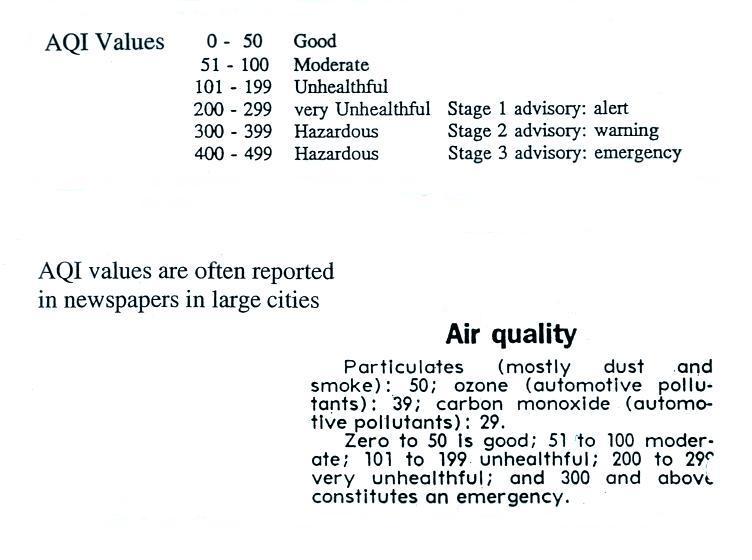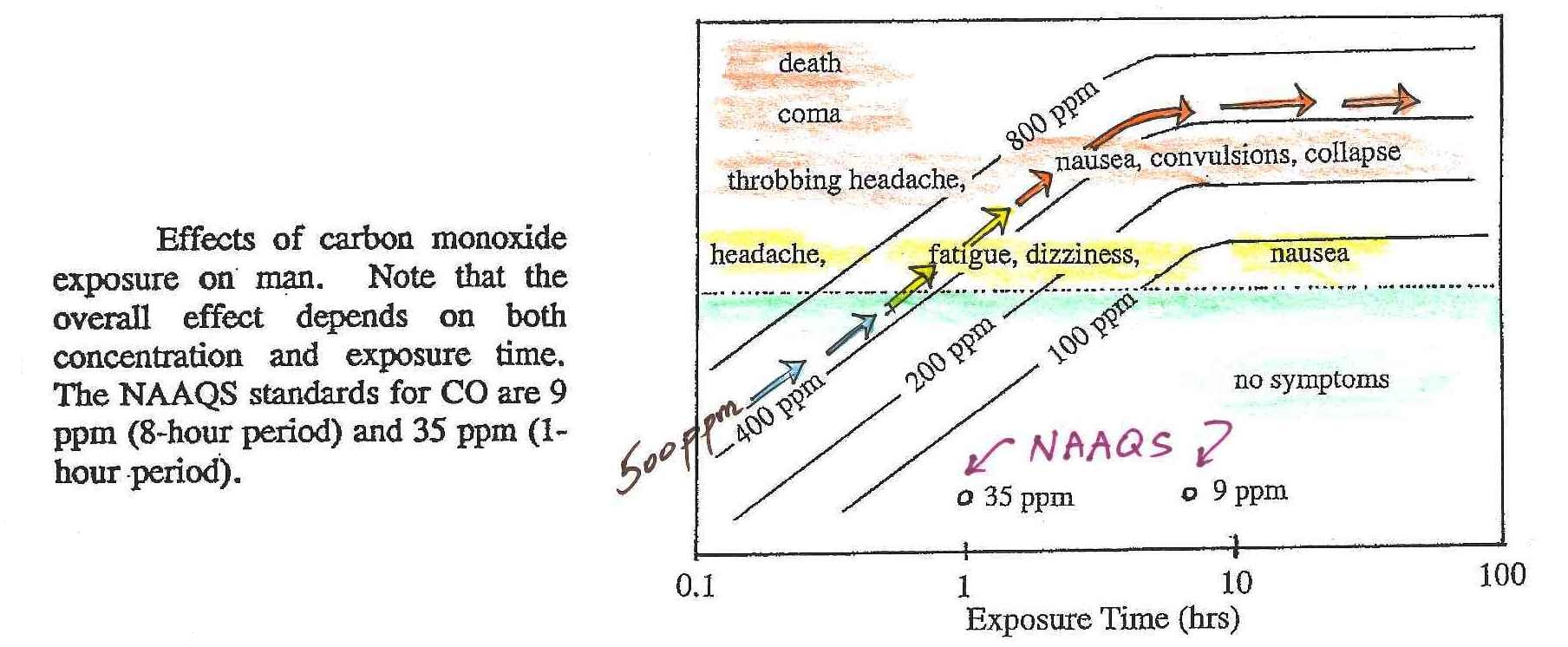Air Quality Index and symptoms of carbon monoxide
poisoning
Here are a couple of short topics that I often have trouble
squeezing into a class lecture.
Air quality index
A large metropolitan area like Tucson and Pima County is required
to continuously measure concentrations of several air
pollutants. You can read more about air quality
monitoring done by the Pima County Department of Environmental
Quality here.
A photograph of one of the monitoring sites (click here to see a map of all 18
monitoring sites) is shown below.
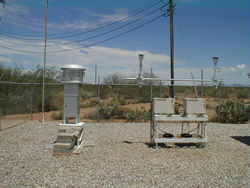
monitoring site at Corona de Tucson (
source)
The main pollutants being monitored are
shown below (see p. 8 in the ClassNotes).
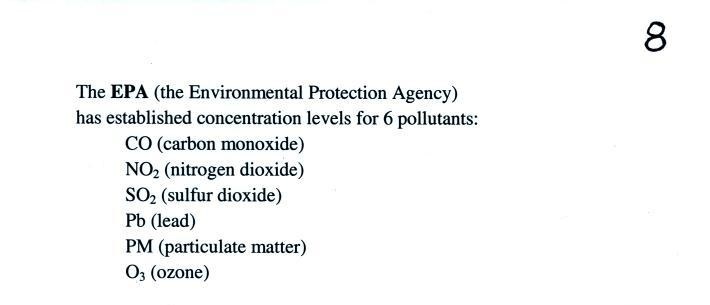
The concentration of
lead in the air has decreased significantly since lead
was removed from gasoline (the following quote is from a
Wikipedia article on gasoline: "In the US,
standards to phase out leaded gasoline were first
implemented in 1973 ..... In 1995, leaded fuel accounted
for only 0.6% of total gasoline sales ...... From 1
January 1996, the Clean Air Act banned the
sale of leaded fuel for use in on-road vehicles.
Possession and use of leaded gasoline in a regular
on-road vehicle now carries a maximum $10,000 fine in
the US.")
In Tucson, carbon monoxide,
ozone, and particulate matter are of primary concern and
daily measurements are reported in the city newspaper.
If I
were to tell you that the measured carbon monoxide
concentration yesterday was 4.5 ppm (averaged over an 8 hour
time period) would you be able to tell me whether that was
high or low, hazardous or not? Most people wouldn't be
able to answer that question. Many people wouldn't
know that ppm stands for "parts per million". Those
are units of concentration (4.5 CO molecules mixed in with 1
million air molecules).
Rather than reporting the actual measured values, an Air
Quality Index value is reported instead.
The AQI is the ratio of the measured to accepted
concentrations multiplied by 100%.
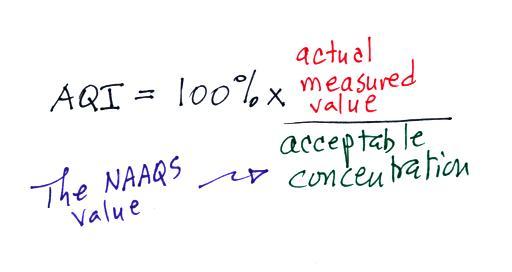
The acceptable levels are known
as the National Ambient Air Quality Standards (NAAQS).
The numbers are different depending on the particular
pollutant.
The NAAQS values for carbon monoxide are:
9 ppm (average value over an 8 hour
period)
35 ppm (average over a 1 hour period)
So we can compute the AQI for a measured CO concentration of 4.5
ppm.
The air quality in this case would be
acceptable. Air becomes unhealthy when the AQI value
exceeds 100%. It's somewhat like computing your
percentage grade on a quiz. You divide the points earned
by the total number of points possible and multiply by
100%. 100% on a quiz is good, an air quality index value
of 100% is bad.
Current Air Quality Index
values for Tucson are probably not in the newspaper
anymore, they're available online.
Symptoms of carbon monoxide poisoning
Carbon monoxide is a
serious hazard indoors where it can build to much
higher levels than would ever be found outdoors.
This next link is to a newspaper article describing an
incident at Virginia Tech (that occurred near the
beginning of the school year in 2007). Carbon
monoxide
from
a malfunctioning hot water heater sickened 23
Virginia Tech students in an apartment
complex. The CO concentration is thought to have
reached 500 ppm. You
can get an idea of what kinds of symptoms and effects that
concentrations this high would cause from the figure in the
middle of p. 9 in the photocopied ClassNotes.
The effects of CO depend on what concentration you exposed to
and the duration of the exposure. In this case we'll
follow the arrows from lower left to the upper right of the
figure. The arrows represent a concentration of about 500
ppm. Beginning at lower left we see that we wouldn't
experience any symptoms with an exposure to even 500 ppm for
just a few minutes. Note also the NAAQS values near the
bottom of the graph. Beginning at about 1 hour exposure
the arrows cross from the lower green half to the upper
yellow and orange half of the graph. Beginning at 1 hour
you would experience headache, fatigue, dizziness, nausea.
The symptoms would worsen if the exposure lasted for a few
hours: throbbing headache, nausea, convulsions, and
collapse. The 500 ppm line comes very close to coma and
death part of the graph. At Virginia
Tech several students were found unconscious and a few had
difficulty breathing on their own but were resuscitated; they
very nearly died.
Carbon monoxide alarms are relatively inexpensive
(~$50) and are available at most hardware stores. I've got
one in my house to protect me and my cats. They will
monitor CO concentrations indoors and warn you when
concentrations reach hazardous levels.
Indoors CO is produced by gas furnaces and water heaters that
are either operating improperly or aren't being properly vented
to the outdoors. A few hundred people are killed indoors
by carbon monoxide every year in the United States. An
operating carbon monoxide alarm probably saved the lives of the
6 Tucson residents in December 2010. You can learn
more about carbon monoxide hazards and risk prevention at the Consumer
Product Safety Commission web page.




